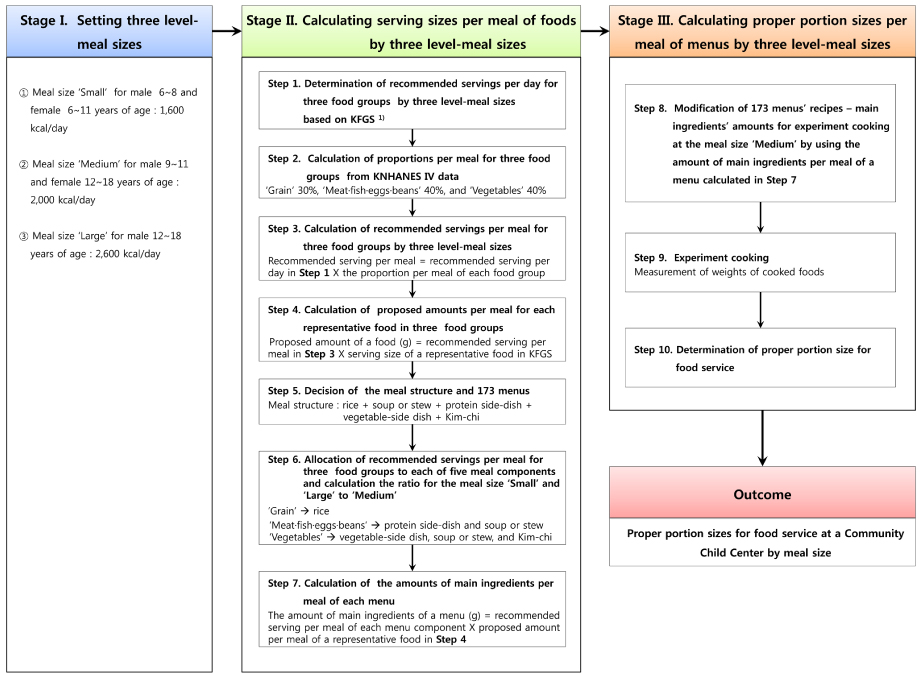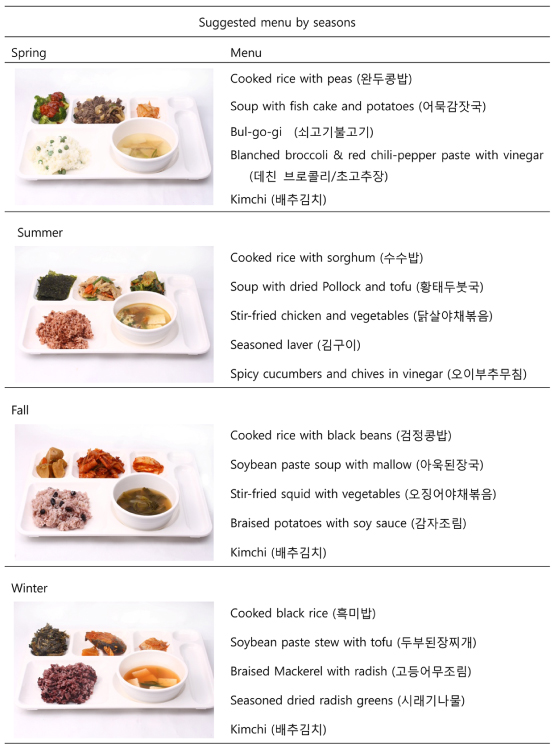Korean J Community Nutr.
2014 Aug;19(4):361-371. 10.5720/kjcn.2014.19.4.361.
Recommendation of Serving Size of the Meal Service of Community Child Centers in Korea
- Affiliations
-
- 1Department of Food and Nutrition, College of Human Ecology, Seoul National University, Seoul, Korea.
- 2Department of Food and Nutrition, College of Natural Science, Daejeon University, Daejeon, Korea. jshim@dju.kr
- 3Department of Food and Nutrition, College of Health Science, Honam University, Gwangju, Korea.
- 4Geumcheon-gu Center for Children's Foodservice Management, Seoul, Korea.
- 5Research Institute of Human Ecology, College of Human Ecology, Seoul National University, Seoul, Korea.
- KMID: 2268086
- DOI: http://doi.org/10.5720/kjcn.2014.19.4.361
Abstract
OBJECTIVES
This study was performed to set easily applicable portion sizes by sex and age for children at the Community Child Centers (CCC) in Korea.
METHODS
Considering the age and gender specific energy level at Target Patterns for children aged 6-18 years, which were suggested as a part of the 2010 Korean Food Guidance System (KFGS), we set three meal sizes. We reclassified the recommended daily servings of Grains, Meat.fish.eggs.beans and Vegetables group at Target Patterns into three meal sizes, and then calculated the recommended serving per meal. Each proposed amount of food per meal was calculated based on serving size of foods commonly eaten at KFGS, which was then allocated to five meal components; rice, soup, stew, protein and vegetable side-dishes and Kimchi. Each proposed amount of food per meal was applied to 173 menus' recipes from CANpro 3.0 as main ingredient's amounts. We cooked the 173 menus at the medium size and measured their weights after cooking.
RESULTS
Each recommended serving per meal was 0.75, 0.9 and 1.2 for Grains; 1.2, 1.6 and 2.4 for Meat.fish.eggs.beans; 2, 2.4 and 2.8 for Vegetables by meal sizes. Among five meal components, the ratio of small and large to medium size was 1/5 less and 1/3 more for rice and 1/3 less and 1/3 more for soup.stew, protein side-dish and Kimchi, respectively. We suggested the same amount for a vegetable side-dish to encourage vegetable intake. Proper portion sizes per meal of medium were rice 190 g, soup.stew 210 g (solid ingredients 60 g), protein side-dish 100 g (meat.eggs.beans) and 70 g (fish), vegetable side-dish 80g and Kimchi 30 g.
CONCLUSIONS
Proper portion size per meal suggested in this study may be useful at the CCC where dietitians are not available and the approach could be applicable to the other types of meal services.
Keyword
MeSH Terms
Figure
Reference
-
1. Asano K, Yoon J, Yoon B. Appropriate size and dish combination of nutritional-balanced lunch boxes delivered to children under the government-funded meal service program in Korea. Korean J Community Nutr. 2009; 14(5):565–575.2. Chang H, Ko E. The effectiveness of nutrition education provided by dietitians in child care centers. Korean J Community Nutr. 2007; 12(3):299–309.3. Child Welfare Act 2006, Act No.7591, Partial Amendment Jul. 13, 2005. Article 16. Kinds of the child welfare facilities, Amended by Act No. 7143, Jan. 29, 2004. (Jan. 14, 2006).4. Cho HS. A study on the actual condition for portion control of meal served by elementary school foodservice operation. Korean J Food Nutr. 1998; 11(1):54–60.5. Cho HS. A study on the development of properly portioned meal sizes in the industry foodservice. Korean J Food Nutr. 1999; 12(1):26–32.6. Choi MK, Lee HS, Kim SB, Kim SN, Kim SY, Kim MH. Establishment of one portion size of foods frequently consumed by Korean children aged 6-11 using 2005 Korea National Health and Nutrition Examination Survey and its comparison with adults. Korean J Community Nutr. 2010; 15(5):625–635.7. Chung M, Lee YM, Lee KW. A study on the nutritional evaluation and food service managements of snacks in early childhood education institute. J Korean Home Econ Assoc. 2000; 38(4):99–113.8. Fisher JO, Kral TV. Super-size me: portion size effects on young children's eating. Physiol Behav. 2008; 94(1):39–47.9. Fisher JO, Liu Y, Birch LL, Rolls BJ. Effects of portion size and energy density on young children's intake at a meal. Am J Clin Nutr. 2007; 86(1):174–179.10. Hwang JK, Lim JK, Shin YJ, Choi Y, Kim MS, Park YS, Kim SA. Evaluation report of community child centers in 2009. Report of Ministry of Health and Welfare in Korea. Seoul: Program Evaluation Support Group for Community Child Centers;2009.11. Kim HY, Kim CM, Ko SH. A study on the actual condition for portion control of meal served by food service operation. Korean J Diet Cult. 1997; 12(1):79–86.12. Kim MS, Kim HR, Cho AJ, Lee HW, Hong M, Kim HJ. Status on foodservice program for low-income children. Report of National Human Rights Commission of Korea. Seoul: National Human Rights Commission of Korea;2007.13. Kwon S. Development and evaluation of the support model for foodservice management of community child centers in Korea. Seoul National University;2011. 37–87. Dissertation.14. Kwon S, Lee K, Yoon J. Diet of children under the government-funded meal support program in Korea. Nutr Res Pract. 2010; 4(6):515–521.15. Lee Y, Oh YJ. A study on the meal portion size of kindergarten. Korean J Nutr. 2007; 40(1):89–96.16. Lee YJ, Chang KJ. Preliminary study on the establishment of proper portion using consumed size and food preference of frequently served meals in the elementary school lunch program in Inchon: I. a study on food preference of frequently servedmeals in the elementary school. J Korean Diet Assoc. 1998; 4(2):123–131.17. Lee YJ, Chang KJ. Preliminary study on the establishment of proper portion using consumed size and food preference of frequently served meals in the elementary school lunch program in Inchon: II. a study on the consumption size of frequentlyserved meals in the elementary. J Korean Diet Assoc. 1998; 4(2):132–144.18. Ministry of Health and Welfare, Headquarters for Community Child Center. Report of current status of community child centers in Korea (2013. 06). Seoul: Headquarters for Community Child Center;2013.19. Ramsay SA, Branen LJ, Johnson SL. How much is enough? Tablespoon per year of age approach meets nutrition needs for children. Appetite. 2012; 58:163–167.20. Shim JE, Yoon J, Lee K, Kwon S. Evaluation of dietary intake of Korean school-aged children from low-income families by comparing with the Korean food guide: analysis of the data from the 2001 National Health and Nutrition Survey. Korean J Nutr. 2009; 42(8):691–701.21. Son JH, Chyun JH. Comparative study of satisfaction level on hospital meal size and actual intake rate between elderly and middle age patients. Korean J Food Cult. 2002; 17(5):619–628.22. The Korean Nutiriton Society. Dietary reference intakes for Koreans. 1st revision. Seoul: The Korean Nutiriton Society;2010. p. 524–547.23. Yoon J. Study on safety management in food service for children from low income families. Report of the Ministry of Food and Drug Safety in Korea. Cheongju: Ministry of Food and Drug Safety;2010.
- Full Text Links
- Actions
-
Cited
- CITED
-
- Close
- Share
- Similar articles
-
- Current Status and Management of Congregate Meal Service Program for the Elderly at Community Centers
- School Dietitians' Satisfaction with and Needs for School Meal Service Support Centers
- Food Service Status at Community Child Care Centers in Busan
- A Study on the Meal Portion Size of Kindergarten
- Characteristics of the Organizational Structures of Free Meal Service Centers and Cooperation with Community



